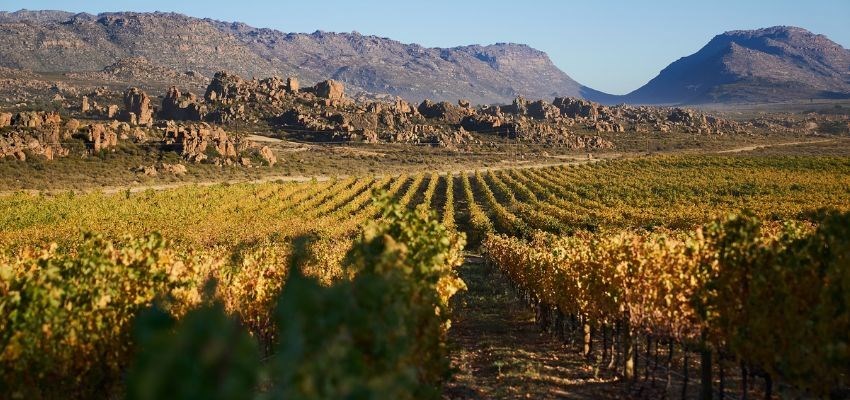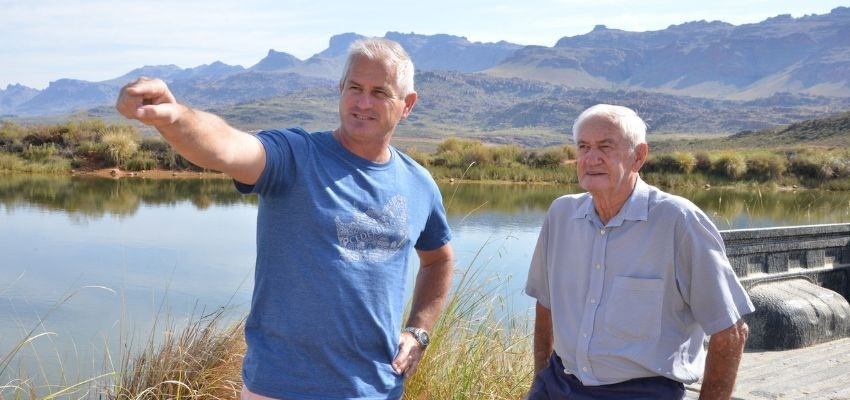
The beauty of the winelands delights all who visit the Cape; it’s a beauty distinctive to each area, making it unnecessarily difficult to pick a favourite.
One region remarkable for its isolated beauty is the dramatic and spectacular Cederberg. Covering 66811 ha of mountainous terrain on the West coast, the fynbos-rich Cederberg was proclaimed a Wilderness in 1973. It is a haven for campers, mountain climbers, hikers, rock art and wildlife enthusiasts and anyone who likes to get away from it all.
It’s also a haven for wine lovers. Originally inhabited by the Khoisan people, in 1800 the Nieuwoudt family settled in the region, moving, in 1893, to Dwarsrivier, the home of Cederberg Wines.
Originally a fruit farm, one story of how vines came to be planted goes that noting the quality fruit, a friend of Pollie Nieuwoudt’s on the Deciduous Fruit Board, recommended planting table grapes. This recommendation, implemented in 1965, proved such a success, wine grapes were introduced in 1973. Cabernet sauvignon was one of the first varieties planted; the first commercialized vintage, 1978, carried off the local Grand Champion award and a national gold medal.
I remarked to David Nieuwoudt, fifth generation and current winemaker, that back then, high-altitude cabernet was forward-thinking of his grandfather. ‘Altitude must have late-ripening reds,’ he explains, ‘there’s a massive diurnal difference and the grapes are ripened by time – slowly - rather than sun.’ Time is of no problem, as there is no rain until May.
There’s also a logical reason why Oom Pollie planted bukettraube in 1984. ‘It produces a clean, aromatic white, from higher yields (then an asset) but it’s sensitive to downy mildew,’ David tells me. ‘It has a completely different flavour profile here from warmer regions, like Swartland and Paarl, where it was planted;’ he adds; ‘here we enjoy a much higher natural acid and no downy mildew.’ The wine, with its few grams of natural sweetness, makes a great match for spicy dishes and is much loved by the Americans. If popularity can be measured by plantings, David has just added four ha making a total of 11ha on the farm, which has 74 ha total under vine.

Morning father and son catch ups on the farm
Although based in the Cederberg, David also makes wine from another cool-climate area, Elim – ‘Exactly 449 kms from here,’ he details. ‘It’s a phenomenal region, the best kept secret for sauvignon blanc with a unique identity. And the coldest region in South Africa.’ He points to semillon, syrah and pinot also doing well, with great identity. The fruit is hand-harvested into small crates and brought back to the Cederberg cellar in a refrigerated truck.
Much thought and care went into creating a cellar that reflects the natural beauty of this wilderness area. The old cold rooms and space from the days when it was a fruit farm, were converted by a British architect. Everything brought in was local, locals too built the cellar, learning many skills along the way. Clay from Simondium, the same iron oxide red as Wolfberg Cracks, a local landmark, was used to form the cellar bricks. These were all cut by farm manager, Mario; 272000 bricks in total, which took three and a half years to hand-cut and lay them. The pebble wall feature in the tasting room was also his work, after 18 women had taken 16 days to collect them from the local river. As for the tables and stands, these were fashioned from old pine trees felled by David’s grandfather in 1964. All this was done to meet David’s wish for a farm that’s part of the Cederberg, rather than a flashy standout construction; this has been beautifully realised.
It will soon be full of the sounds and smells of harvest 2024, a year David describes as promising a bigger crop than 2023 with healthy, if very small berries due to December temperatures dropping as low as 3C on three occasions and requiring the fans to be switched on to avoid frost damage. The results are eagerly awaited.
This article was originally published on WOSA's blog, Cape Chatter.